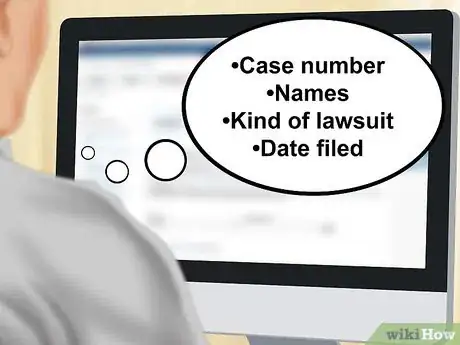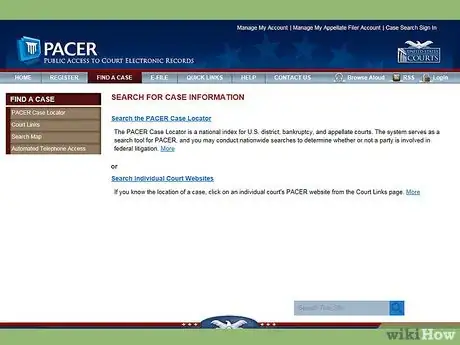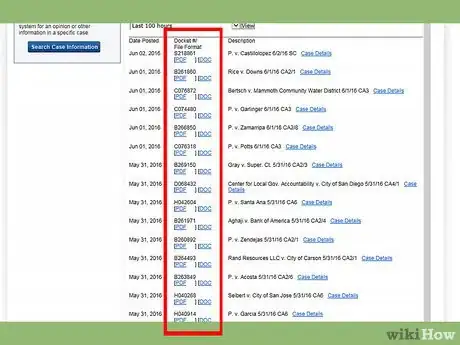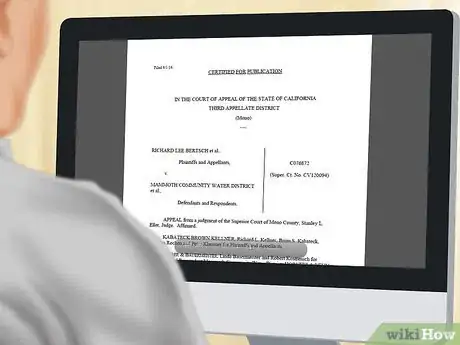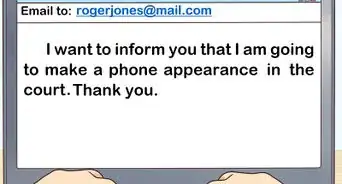X
This article was co-authored by Clinton M. Sandvick, JD, PhD. Clinton M. Sandvick worked as a civil litigator in California for over 7 years. He received his JD from the University of Wisconsin-Madison in 1998 and his PhD in American History from the University of Oregon in 2013.
This article has been viewed 29,307 times.
Generally, the documents filed in a court case are available for public inspection.[1] To find a court document, you need to find the courthouse in which the lawsuit was filed. Some courts have electronic databases you can search while other courthouses will only have paper copies available. Before beginning your search, you need to find basic identifying information about the court case.
Steps
Part 1
Part 1 of 2:
Locating Public Court Records
-
1Gather relevant information. To find court records, you will need to know basic information about the court case. A court may have heard thousands of cases over the past few years, so you will need some identifying information so that the clerk can pull the correct file. Try to gather as much of the following as possible:
- the case number
- the name of one or both parties to the lawsuit
- what kind of lawsuit it was (civil, family, criminal, probate, etc.)
- when the lawsuit was filed
-
2Visit the courthouse. Although court records are public, some smaller courthouses still only have paper copies available for inspection. Even larger courthouses may have uploaded to the Internet only documents related to newer cases. If you want to find court papers for a case, then you will have to get the paper copy.
- Accordingly, you should stop into the courthouse and ask the court clerk how you can get a copy of a court record. Tell the clerk you want to see the whole case file.[2]
- There should be photocopiers available to photocopy. Bring some money as you probably will have to pay to make copies.
Advertisement -
3Perform a web search. You might also want to look on the web for court documents. A surprising number of court documents have shown up on the Internet over the past few years. If you are looking for documents in a court case involving a large corporation, the complaint and other documents could be on the web.
- To search, type the name of the lawsuit (if you have it) or the name of the company and “lawsuit.”
- This type of general web search will probably not work for lawsuits involving private citizens (instead of large corporations).
-
4Search PACER for federal cases. PACER is the federal system for storing court records. The acronym stands for “Public Access to Court Electronic Records.” It contains records for the federal bankruptcy, district, appellate and Supreme courts.
- To use PACER, you first need to create an account. You can do so by clicking https://pacer.psc.uscourts.gov/pscof/registration.jsf and entering the requested personal information.
- Once you have an account you can search by clicking the “Find a Case” heading and then clicking on the “Search the PACER Case Locator” hyperlink. Then enter your account log-in information.
- At the Case Locator page, you can search by Case Number or by Party Name.[3] You can then scan through the list of cases that are pulled up and click on the hyperlink to the relevant case.
-
5Find a state database. PACER only has federal court documents. If the lawsuit was held in a state court, then you will need to find the state equivalent to PACER.
- To find a state electronic database, search the web. Type “case search” and then the state where the trial was held.
- You can also search legaldockets.com. This website contains links to all of the states in the U.S. as well as territories. After clicking on a state, you can select the appropriate court from a list that is generated. You will then be redirected to that court’s search engine.
-
6Search the state database. Once at the website, you can search using various information. Click “Search” once you have entered as much case information as you possess:[4]
- party name (you must include first and last name)
- birth date of a party (use only in conjunction with name information)
- the business name of a party
- case number
Advertisement
Part 2
Part 2 of 2:
Reading Court Records
-
1Understand the life cycle of a case. A typical civil lawsuit is initiated by filing a complaint.[5] In a criminal case, the case is started with the filing of an indictment. After the case has started, then the parties can bring various motions.
- Pre-trial motions. In the months leading up to the trial, each party will file motions asking the judge to do something. There are many kinds of motions. Generally, parties file motions to have the case dismissed or to compel the discovery of documents or other information.
- Trial exhibits. If something is submitted during the trial as an exhibit, it should be included in the file. However, you probably will not find trial transcripts in the record unless one party took an appeal.
- Rulings. These should appear soon after the relevant motion. The judge will rule on a motion soon after it is brought. Accordingly, if you find a motion in the court file, then you should look for the court’s order to appear shortly thereafter.
- Judgment. The judgment is the disposition of the case. It tells you who won and who lost. For this reason, it comes near the end of the case file. If one party takes an appeal or if the parties argue over attorneys’ fees, then these documents will appear after the judgment.
-
2Find the record you are looking for. Now that you have a general sense of the life cycle of a trial, you should be able to find the documents you are looking for quite easily. If you want to see what actions a person was accused of, then search for a copy of the complaint or indictment, which is at the beginning of the file.
- If you want to see what a judge decided at a hearing, look toward the middle of the file. Likewise, if you want to see which party won the lawsuit and how much they were awarded in money damages, then look toward the end of the file.
- Even a short case can generate hundreds of documents, so you should be prepared to scroll through the entire list of documents in order to find exactly what you are looking for. Each document should be listed with a heading, e.g., “Defendant’s Motion for Summary Judgment.”
-
3Pull up the record. In an electronic database (like PACER or a state equivalent), you can retrieve the record by clicking on the hyperlink. A PDF or html image will then appear. You can print it off.
- PACER charges 10 cents per page retrieved. There is a 30 page cap, so the most you will be charged per document retrieved is $3.00. If you charge less than $15 a quarter on PACER, then fees are waived.[6]
-
4Read the court document. Court documents are generally easier to read than legislative statutes. At the top of most documents should be the caption, which lists the parties, the case number, and the name of the court. Sometimes the judge is also named.[7]
- The motion should have a title below the caption. For example, a motion for summary judgment should be titled as such. Make sure the document is actually what was described in the hyperlink.
- You can then read the document. Make sure you know who the Defendant is and who the Plaintiff is, otherwise you might get confused. Check the caption to confirm the identities of the parties.
Advertisement
References
- ↑ http://www.illinoislegalaid.org/index.cfm?fuseaction=home.dsp_content&contentID=7732
- ↑ http://www.illinoislegalaid.org/index.cfm?fuseaction=home.dsp_content&contentID=7732
- ↑ https://pcl.uscourts.gov/search
- ↑ https://wcca.wicourts.gov/simpleCaseSearch.xsl;jsessionid=854E11EAA0A8CF720E0C8457BC2D60D9.render6
- ↑ http://legal.osu.edu/help_litigation.php#lifecycle
- ↑ https://www.pacer.gov/psc/faq.html
- ↑ http://courts.delaware.gov/forms/download.aspx?id=45678
About This Article
Advertisement
